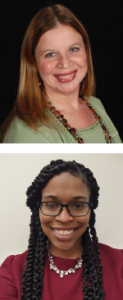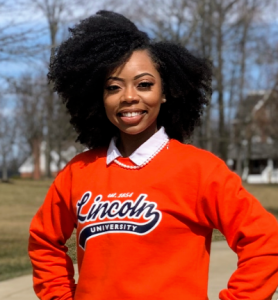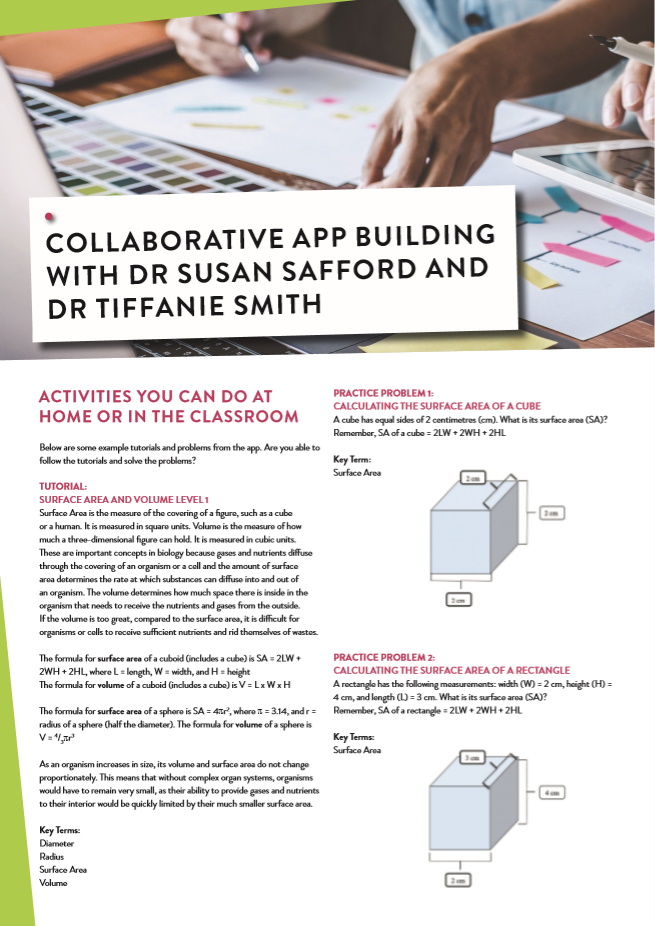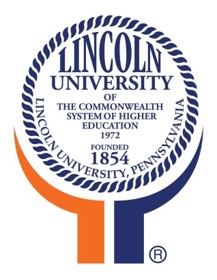How to design a biology and maths app for students, by students
Maths may not always be a favourite area for biologists, but it is crucial to understanding science. After seeing biology students struggling to apply maths to their studies, Dr Susan Safford, at Lincoln University in the US, decided to develop an app to tackle the problem. To do this, she assembled an interdisciplinary team of professors, including Dr Tiffanie Smith, and students from across biology, maths and computer science
Ashmun Express is an app designed to help undergraduate students tackle mathematical problems in biology. It is targeted at students in lower level biology classes, who need support to realise their full potential. It provides short tutorials and example problems based around biology questions, helping students to make the connection between maths and biology.
BEGINNINGS
Named after Lincoln University’s former title, the Ashmun Institute, the idea for the app came from the observation of two perceived issues. The first was the need for biology students to engage with maths and make the connection between the two fields. The second was the need for a learning tool that was student-driven and supported underrepresented minorities.
When developing course materials, many organisations and universities overlook the needs of underrepresented minorities, which can lead to challenges in their studies. Lincoln University in the US, where the app was created, is a Historically Black University. By including student input at every level, the development process ensured that the needs of minorities were taken into account.
THE DEVELOPMENT JOURNEY
Since Autumn 2016, Susan has recruited a number of professors and students to help develop the app. Fifteen students have been involved, studying courses in biology, computer science and maths, while six professors from across the same fields have also lent their insight. Tiffanie is an assistant professor in the Department of Computer Science at Lincoln University and co-Principal Investigator, meaning she co-leads the Ashmun app project with Susan.
As often happens with any development process, there were a few setbacks to the app’s development. A high turnover of computer science professors meant that parts of the app had to be re-coded or re-formatted to account for differing preferred methodologies. Testing and loading the app on personal devices also threw up problems, and troubleshooting could be painstaking. However, this meant the students involved learnt a valuable lesson about the rarity of plain sailing in a development process, and how those involved can deal with obstacles as they emerge.
STUDENT INPUT
Directly hearing from students about the problems they encountered, and how they could be remedied, was a core part of the development process from the outset. Susan, Tiffanie and their colleagues discussed, with students, which maths problems in a biology context they found difficult and worked with them to find straightforward ways of explaining these concepts and cementing their knowledge. Students also wrote the code and worked on the user engagement aspect of the app.
Ultimately, the process led to strong rewards for the students involved. Collaborating with peers was a common favourite aspect, along with the sense of fulfilment on knowing their work would benefit future students. Of course, there were plenty of practical skills learned along the way too: coding, maths problems, designing and executing sample problems, and the fine art of collaborative working.
WHY MATHS IS IMPORTANT TO BIOLOGY
Take genetics, for instance. Genetics underpins much of modern-day medicine and biological understanding, and the laws of genetic inheritance are governed by maths. At its simplest, an understanding of probability, ratios and arithmetic is needed to get a grasp on genetics. Without these skills, students can struggle to understand cancer, genetic diseases and a host of other biological problems.
Physiology is another area of biology where maths comes to the fore. For instance, surface areas and volumes of organisms (and their body parts) govern how quickly heat is lost, how much oxygen they need to respire, and how they absorb their food. In medicine, for example, understanding these maths-based characteristics is necessary for medical dosing and calculating the likelihood of certain diseases.
Reference
https://doi.org/10.33424/FUTURUM61
Ashmun Express is an app designed to help undergraduate students tackle mathematical problems in biology. It is targeted at students in lower level biology classes, who need support to realise their full potential. It provides short tutorials and example problems based around biology questions, helping students to make the connection between maths and biology.
BEGINNINGS
Named after Lincoln University’s former title, the Ashmun Institute, the idea for the app came from the observation of two perceived issues. The first was the need for biology students to engage with maths and make the connection between the two fields. The second was the need for a learning tool that was student-driven and supported underrepresented minorities.
When developing course materials, many organisations and universities overlook the needs of underrepresented minorities, which can lead to challenges in their studies. Lincoln University in the US, where the app was created, is a Historically Black University. By including student input at every level, the development process ensured that the needs of minorities were taken into account.
THE DEVELOPMENT JOURNEY
Since Autumn 2016, Susan has recruited a number of professors and students to help develop the app. Fifteen students have been involved, studying courses in biology, computer science and maths, while six professors from across the same fields have also lent their insight. Tiffanie is an assistant professor in the Department of Computer Science at Lincoln University and co-Principal Investigator, meaning she co-leads the Ashmun app project with Susan.
As often happens with any development process, there were a few setbacks to the app’s development. A high turnover of computer science professors meant that parts of the app had to be re-coded or re-formatted to account for differing preferred methodologies. Testing and loading the app on personal devices also threw up problems, and troubleshooting could be painstaking. However, this meant the students involved learnt a valuable lesson about the rarity of plain sailing in a development process, and how those involved can deal with obstacles as they emerge.
STUDENT INPUT
Directly hearing from students about the problems they encountered, and how they could be remedied, was a core part of the development process from the outset. Susan, Tiffanie and their colleagues discussed, with students, which maths problems in a biology context they found difficult and worked with them to find straightforward ways of explaining these concepts and cementing their knowledge. Students also wrote the code and worked on the user engagement aspect of the app.
Ultimately, the process led to strong rewards for the students involved. Collaborating with peers was a common favourite aspect, along with the sense of fulfilment on knowing their work would benefit future students. Of course, there were plenty of practical skills learned along the way too: coding, maths problems, designing and executing sample problems, and the fine art of collaborative working.
WHY MATHS IS IMPORTANT TO BIOLOGY
Take genetics, for instance. Genetics underpins much of modern-day medicine and biological understanding, and the laws of genetic inheritance are governed by maths. At its simplest, an understanding of probability, ratios and arithmetic is needed to get a grasp on genetics. Without these skills, students can struggle to understand cancer, genetic diseases and a host of other biological problems.
Physiology is another area of biology where maths comes to the fore. For instance, surface areas and volumes of organisms (and their body parts) govern how quickly heat is lost, how much oxygen they need to respire, and how they absorb their food. In medicine, for example, understanding these maths-based characteristics is necessary for medical dosing and calculating the likelihood of certain diseases.
WHAT’S NEXT?
The app is in the prototype stage and has been used within classes on the campus of Lincoln University. The team hopes to have a version ready for the app store by the end of the summer 2020 and will continue to improve its content throughout the coming year.
In the US, student performance in maths lags behind that of many other countries. Success in STEM relies upon a confident understanding in maths, and so addressing this lag is essential. The team believes that students will be more likely to engage with the app knowing that it was developed by students like themselves. They also believe that the app could be useful to students across the world. Maths problems addressed by the app are central to statistics, genetics and many other fields worldwide.
DESIGNING A STUDY APP: WHY COLLABORATE?
To make an app designed to educate, you will need several groups of people:
• People with expertise in the educational material
• People who know the technical details of app building
• People who fit the target audience
A project that lacks any of these groups is unlikely to make a genuinely useful product. By combining these different areas of expertise and experience, the project becomes a collaborative effort, which is how Susan, Tiffanie and their team built Ashmun Express, an app designed to help biology students improve their mathematical skills. Their team involves students and professors from the fields of maths, biology and computer science; together, they fulfil all the criteria listed above.
 DR SUSAN E SAFFORD
DR SUSAN E SAFFORD
Department of Biology,
Lincoln University, USA
DR TIFFANIE SMITH
Department of Computer Science, Lincoln
University, USA
RESEARCH PROJECT: The team at Lincoln University seeks to create an affordable mobile app that focuses on the application of mathematical concepts to biological problems.
FUNDERS: National Science Foundation
 DR SUSAN E SAFFORD
DR SUSAN E SAFFORD
Department of Biology,
Lincoln University, USA
DR TIFFANIE SMITH
Department of Computer Science, Lincoln
University, USA
RESEARCH PROJECT: The team at Lincoln University seeks to create an affordable mobile app that focuses on the application of mathematical concepts to biological problems.
FUNDERS: National Science Foundation
Q&A WITH DR SUSAN SAFFORD AND DR TIFFANIE SMITH
WHAT DID YOU WANT TO BE WHEN YOU WERE YOUNGER?
Susan: I knew from an early age that I wanted to study biology, and knew a PhD was for me by the time I was in middle school, despite this being an unusual aspiration for a woman at the time.
Tiffanie: I originally wanted to be a librarian because of my love of books. As I entered into middle school and we purchased a home computer, I became fascinated and knew I wanted to go into computer technology engineering.
SUSAN, WHAT INSPIRED YOU TO GET INTO BIOLOGY?
There wasn’t any one thing that inspired me to get into the field. I read a lot growing up and was always intrigued by science. I enjoyed maths but didn’t see a future for me as a mathematician. By high school I felt that biology gave me more options, and my biology teacher at that time was instrumental in helping me take my interest forward.
TIFFANIE, WHAT INSPIRED YOU TO GET INTO COMPUTER SCIENCE?
I have always been good at maths and science, so I was encouraged in high school to go into
engineering. I received my Bachelors from North Carolina A&T State University in Computer Engineering, which was a pretty good mix of electrical engineering and computer science. Although I did well in my classes, I was not a fan of the circuitry aspects of the engineering side and decided to pursue my doctoral programme in an interdisciplinary field associated with computer science, called human centered computing.
WERE YOU GOOD AT MATHS AT SCHOOL?
Susan: Yes, and I enjoyed the challenge of solving problems. I loved algebra and was intrigued by calculus. I ended up taking three courses in statistics at graduate school. The way that maths helped me make sense of data and uncover important findings was eye-opening for me. I try to help students see this wonder and how it applies to biological problems.
Tiffanie: Yes, like Susan, I enjoyed the challenge associated with maths. Maths has always come easy to me and I was also always able to explain it to others in a way that they could understand. It didn’t hurt that some of my favourite teachers in middle and high school were my maths teachers.
WHAT WOULD YOU SAY TO STUDENTS WHO DON’T LIKE MATHS?
Susan: I always try and help my students overcome areas they find difficult. One reason I assign maths application problems is to help them see that maths isn’t boring. The repetition involved might be but solving the mysteries of datasets certainly is not.
Tiffanie: It’s okay not to like maths, but it’s necessary to understand it. Although differential equations may not be used on a regular basis, algebra and other foundational maths concepts do play a role in our daily lives
MEET ONE FORMER AND TWO CURRENT LINCOLN UNIVERSITY STUDENTS WHO HAVE WORKED ON THE ASHMUN EXPRESS APP

RUMEEL JESSAMY
Cryptographic Software Developer, IBM
BS Computer Software Engineering, MS Computer Science, MBA Business Administration, Lincoln University
I was the first lead engineer to work on developing the app. I was responsible for all the mobile application development for two years. I took on the project because I wanted to tackle a new challenge while still studying. I figured it would give me some real-world programming experience.
The main challenge I faced was learning to build IOS and Android software with no prior experience. It took me a few months of reading about the programming language to be able to implement it correctly. I also later taught my methods for debugging and problem-solving to other students.
Building this app has taught me that there is no challenge I cannot accomplish if I put in the effort it needs. I believe this app will help teach students the knowledge they need to succeed in their classes. It will not only benefit students, but also give professors an understanding of each of their student’s strengths and weaknesses.
I now work as a firmware engineer, providing cryptography and data security for IBM Systems. I joined IBM in 2018 on the test team and have worked on a number of interesting projects there. I would definitely recommend a career in computer science. It is a challenging field but never boring, and there is a chance to learn something new every day. On top of that, I find it a great work environment, and I love working with all my colleagues and taking part in the events that the company plans. Now, I cannot imagine doing anything else with my life.

BRIANNA BLAKE
Major in biochemistry and molecular biology, minor in biology and bioinformatics, Lincoln University
My role in the app process was to create content for the biology questions, by creating problems at different levels of expertise and finding or creating graphics to accompany them. I was also responsible for overseeing the content database, assisting students using the app and evaluating feedback from users.
I got involved in the project for two reasons. Firstly, I wanted a chance to do some undergraduate research, especially with a professor whose classes I really enjoyed. Secondly, I liked the idea of a student-led project, with the freedom to create content designed by students, for students. Finding questions set at a certain skill level was sometimes challenging, as well as ensuring that the material was transferable to the coding interface. I was able to overcome these challenges by collaborating with professors and other students, and also learnt some tips and tricks for coding.
I have built my understanding of coding and have strengthened my analytical and critical thinking skills. Tutoring and training students, as well as public speaking during presentations, helped develop my collaborative skills.
The app is a great tool for students to tackle interactive problem-solving. Professors can see their progress and tailor their responses to students to help work on their weaknesses.
After my biochemistry studies, I hope to go on to medical school and ultimately conduct biomedical research. I have been accepted into the University of Pittsburgh School of Medicine and am seeking to enter a Medical Scientist Training Programme.

PEDRO MARTINEZ
Major in mathematics, Lincoln University
I was in charge of improving and fixing the ‘probability’ section of the app. With the assistance of a maths professor and the student programmers, I developed new practice questions and examples, and also fixed some issues with the answer key.
I got involved in the project after a maths professor recommended that I assist students already working on the app. Fixing visual mistakes in the app proved a challenge for me, but I fixed it with the help of the student programmers.
Teamwork is key when you reach a difficult hurdle. During this project, I learnt how to use a new programming language and was also able to gain leadership and teamwork skills through our focus on collaboration.
The app has clear explanations and many examples for practice, so should be useful for many students.
Currently, I am working and revising for exams to become a licensed actuary, after which I can work for an insurance company or investment bank. Once I’ve gained skills and knowledge of the industry, I plan to start my own consulting company or hedge fund to help people grow their wealth and plan for the future.




